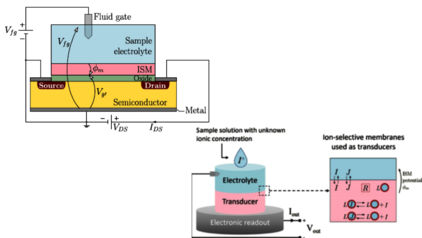

Modeling of ion sensors and ion-tronic devices
Fields such as personalized medicine, precision agriculture and neuroscience require electronic devices able to interact with the biochemical world. Among these devices, transistors with surfaces functionalized to bind with specific ions and molecules as well as protruding transistors able to access the intra-cellular milieu allow exploiting the advantage of the nanoelectronic technology to obtain fast, accurate and scalable biochemical sensors. In this field, our group has developed many models to study the selectivity, sensitivity and time-response of miniaturized ion-sensitive and biological sensors, both by customizing commercial platforms such as the TCAD tool Sentuarus and COMSOL Multiphysics and by developing specific models in scripting languages. Evolutions of the ion-sensitive transistor feature an ion-selective membrane, that is widely employed in electrochemistry. Models for ion-selective membranes and conductive polymers have been developed too, paving the way to the simulation of ion-tronic devices, where ions are used as charge carrier instead of the electrons. These devices can sense, capture and release ions, allowing direct interface with biological entities such as cells and neurons.
Selected publications
Selectivity, Sensitivity and Detection Range in Ion-Selective Membrane-Based Electrochemical Potentiometric Sensors Analyzed With Poisson-Boltzmann Equilibrium Mode
L. J. Mele, P. Palestri, M.A.Alam, L. Selmi, IEEE Sensors Journal, vol. 22, n.15, p.15010, 2022.
Modeling Non-Equilibrium Ion-Transport in Ion-Selective-Membrane/Electrolyte Interfaces for Electrochemical Potentiometric Sensors
L. J. Mele, P. Palestri, L. Selmi, M.A.Alam, IEEE Sensors Journal, vol. 22, n.13, p.12987, 2022.
Multiscale simulation analysis of passive and active micro/nano-electrodes for CMOS-based in-vitro neural sensing devices
F.Leva, P. Palestri, L. Selmi, Philosophical Transactions A, vol. 380, p. 20210013, June 2022.
Sensitivity, Noise and Resolution in a BEOL-Modified Foundry-Made ISFET with Miniaturized Reference Electrode for Wearable Point-of-Care Applications
F. Bellando, L.J. Mele, P. Palestri, J. Zhang, A.M. Ionescu, L. Selmi, MDPI Sensors, v.21, p.1779, March 2021.
General Model and Equivalent Circuit for the Chemical Noise Spectrum Associated to Surface Charge Fluctuation in Potentiometric Sensors
L.J. Mele, P. Palestri, L. Selmi. IEEE Sensors Journal, vol. 21, n.5, p. 6258, 2021.
General Approach to Model the Surface Charge Induced by Multiple Surface Chemical Reactions in Potentiometric FET Sensors
L. J. Mele, P. Palestri, L. Selmi, IEEE Transactions on Electron Devices, vol. 67, n. 3, p.1149, 2020
TCAD-Based Methodology to Model the Site-Binding Charge at ISFET/Electrolyte Interfaces
A. Bandiziol, P. Palestri, F. Pittino, D. Esseni, L. Selmi, IEEE Transactions on Electron Devices, vol. 62, p. 3379, 2015.
Models for the use of commercial TCAD in the analysis of silicon-based integrated biosensors
F. Pittino, P. Palestri, P. Scarbolo, D. Esseni, L. Selmi, Solid State Electronics, vol. 98, pp. 63-69, 2014.

